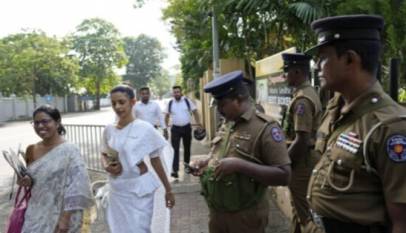Bangladesh becomes 4th largest
remittance source for India
Over 1.0 m Indians working illegally in BD
Special Correspondent: Bangladesh becomes 4th largest remittance source for India, remitting over $10.00 billion since 2017. Whereas, Bangladesh has fetched total of $18.53 billion remittance in last year and targets $26 billion for FY 2021-22. India remits $ 8.320 billion in 2016 from Bangladesh, which was $4.5 billion in 2014. The remittances were sent through illegal channels but deposited with declaration to different Indian banks, told the sources of the Reserve Bank of India. Illegal foreign worker can’t remit money from Bangladesh but the illegal Indians are frequently doing the practice.
Due to recent economic debacle and crisis in the South Asian countries, the issue of Indian remittance source from Bangladesh is spoken much in different forum.
Sources told that the Indian workers mostly deployed in different garment and textile factories mainly dealing the merchandising and buyer handling touchy issues. Our apparel manufacturers also treat it as a prestigious concern to employ Indian people in the technical positions, despite having efficient manpower in Bangladesh.
BGMEA, the apex body of garment sector also never emphasises on the skill development of the workers for the technical positions including, merchandizing, fashion designing and buyer handling.
There are hundreds of thousands of Indians in Bangladesh, most of them are illegal migrants and refugees. According to data produced by the Ministry of Home Affairs, as many as 500,000 Indians were staying in Bangladesh illegally in 2009. Now the number has increased to one million. They were found working in different establishments such as NGOs, garments, textile, IT and sent money back home through hundi transfer systems. But actual figure of illegal Indians in Bangladesh may be one million till date, it is also forecasted by World Bank and International Migration Organisation of United Nations.
In 2020, Bangladesh was the fifth among the nations sending highest remittances to India. Indians working in Bangladesh sent more than $10.20 billion back to India in 2020. Making Bangladesh the 4th largest source of remittance in India. This is the official figure while the unofficial figure is estimated to be significantly more. Most of them came on tourist visas and tended to stay back.
The migrant community has often been a source of contention between the two countries; according to available reports, the lakhs of Indians illegally staying in the country hailed from the Indian states of West Bengal, Delhi, Tamil Nadu, MP, UP and Gujarat and were spread across numerous urban and rural areas.
The CPD at a recent press conference said Bangladesh has become the 4th largest remittance source of India, with around $10 billion dollar sent in 2017.
The issue of outflow of funds to neighbouring India deserves immediate official attention. Thousands of so-called skilled Indian and Sri Lankan nationals, both legal and illegal, have been working mainly in the country’s apparel industry. Because of the geographical proximity, the number of Indian nationals is far greater than that of the Lankans.
Many Indian nationals are, reportedly, also working in the information technology (IT) sector and a good number of them do not have valid work permits. The government agencies concerned have never taken the issue of illegal foreign nationals in due cognizance for reasons best known to them. Only recently, the law enforcing agencies managed to detain a few illegal foreign nationals, most of whom have their origins in Africa.
A country which has considerable dependence on the remittance money earned by its nationals at the cost of their sweat and blood cannot afford the reverse flow of funds for reasons that can be addressed rather easily.
But there is no room for any further delay to find out the replacement and stop the outflow of hard-earned foreign exchange. There are lots of technical institutions imparting primary, intermediate and higher level technical education. The trade bodies representing the apparel sector might sponsor foreign trainers so that a few of these institutions can create skilled hands enough to meet the requirement of their member units.
The sources of Bangladesh Bank told Daily Industry that the boosting of foreign currency reserve has become stagnant due to fund erosion by the illegal foreign expats. The forex reserve stood at $ 33 billion in 2016 but there is not increase during last three years, whereas, the export earnings have increased around 7 percent and the remittance of the country slightly decreased, the BB sources added.
Bangladesh becomes 4th largest remittance source for India, remitting about $10.00 billion in 2020. Whereas, Bangladesh has fetched total of $13.53 billion remittance in the same year. India remits $ 8.320 billion in 2016 from Bangladesh, which was $4.5 billion in 2014. The remittances were sent through illegal channels but deposited with declaration to different Indian banks, told the sources of the Reserve Bank of India. Illegal foreign worker can’t remit money from Bangladesh but the illegal Indians are frequently doing the practice.
There are hundreds of thousands of Indians in Bangladesh, most of them are illegal migrants and refugees. According to data produced by the Ministry of Home Affairs, as many as 500,000 Indians were staying in Bangladesh illegally in 2009. They were found working in different establishments such as NGOs, garments, textile, IT and sent money back home through hundi transfer systems. But actual figure of illegal Indians in Bangladesh may be one million till date, it is also forecasted by World Bank and International Migration Organisation of United Nations.
In 2012, Bangladesh was the fifth among the nations sending highest remittances to India. Indians working in Bangladesh sent more than $3.7 billion back to India in 2012. Making Bangladesh the 5th largest source of remittance in India. This is the official figure while the unofficial figure is estimated to be significantly more. Most of them came on tourist visas and tended to stay back.
The migrant community has often been a source of contention between the two countries; according to available reports, the lakhs of Indians illegally staying in the country hailed from the Indian states of West Bengal, Meghalaya, Assam, Tripura and Mizoram and were spread across numerous urban and rural areas.
The CPD at a recent press conference said Bangladesh has become the 4th largest remittance source of India, with around $10 billion dollar sent in 2020.
The issue of outflow of funds to neighbouring India deserves immediate official attention. Thousands of so-called skilled Indian and Sri Lankan nationals, both legal and illegal, have been working mainly in the country’s apparel industry. Because of the geographical proximity, the number of Indian nationals is far greater than that of the Lankans.
Many Indian nationals are, reportedly, also working in the information technology (IT) sector and a good number of them do not have valid work permits. The government agencies concerned have never taken the issue of illegal foreign nationals in due cognizance for reasons best known to them. Only recently, the law enforcing agencies managed to detain a few illegal foreign nationals, most of whom have their origins in Africa.
A country which has considerable dependence on the remittance money earned by its nationals at the cost of their sweat and blood cannot afford the reverse flow of funds for reasons that can be addressed rather easily.
But there is no room for any further delay to find out the replacement and stop the outflow of hard-earned foreign exchange. There are lots of technical institutions imparting primary, intermediate and higher level technical education. The trade bodies representing the apparel sector might sponsor foreign trainers so that a few of these institutions can create skilled hands enough to meet the requirement of their member units.
The sources of Bangladesh Bank told Daily Industry that the boosting of foreign currency reserve has become stagnant due to fund erosion by the illegal foreign expats. The forex reserve stood at $ 33 billion in 2016 but there is not increase during last three years, whereas, the export earnings have increased around 7 percent and the remittance of the country slightly decreased, the BB sources added.
Rare Israeli airstrike in Beirut kills Hezbollah commander and more than a dozen others
International Desk: Israel launched a rare airstrike that killed a senior Hezbollah milita…








